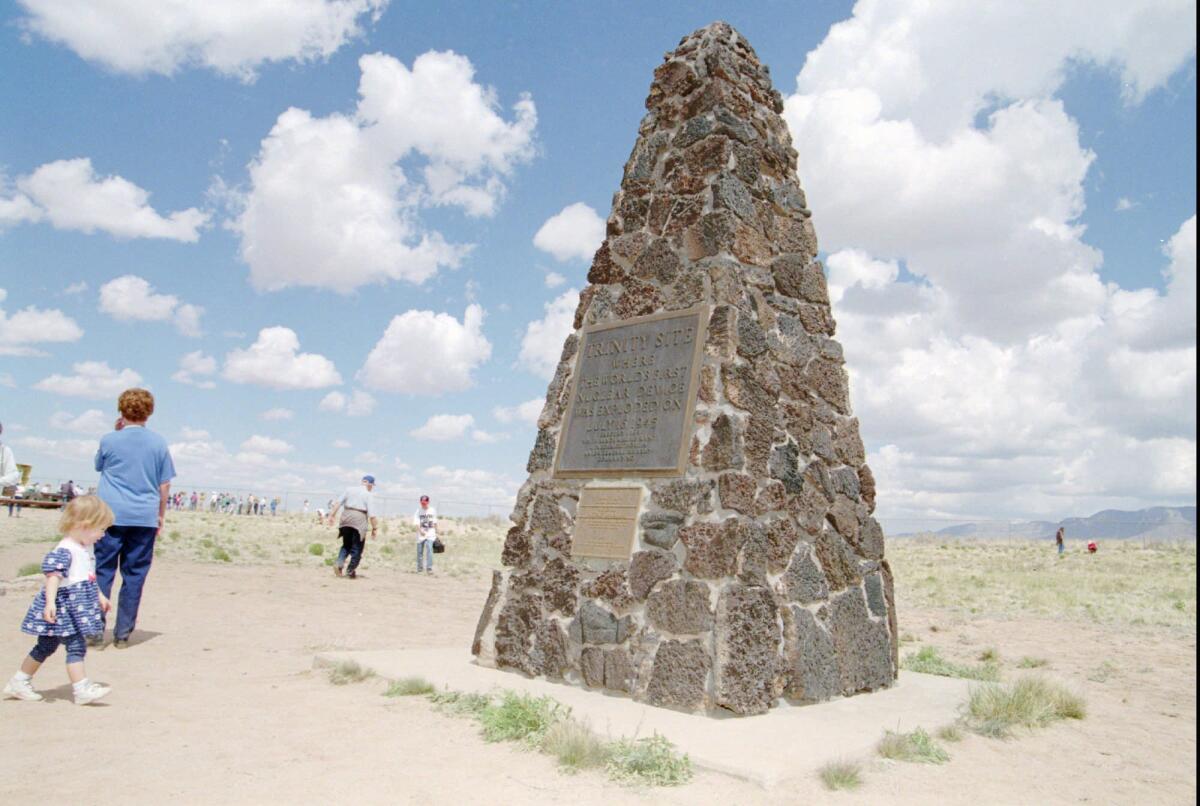At Trinity Site, varied views of atomic past

- Share via
It’s called the Trinity Site, an expanse of baked-white land in the middle of the Chihuahuan Desert — the spot where “the gadget” was set off, launching an era of nuclear proliferation.
Reactions to this place — the site of the world’s first atomic bomb test on July 16, 1945 — vary widely and are usually influenced by age and background.
For a 65-year-old Californian, it summons images of having to hunker below her school desk in a drill during the Cold War.
For a 79-year-old Texan, it conjures up memories of sitting next to the radio as joyous news arrived — World War II was over and the boys were finally coming home. Later, her reactions became more complicated, when she heard about the atomic carnage from her Japanese-born daughter-in-law.
For many younger Americans, it’s a tourist spot. For a local scientist, it’s a geological wonderland.
The place is only open to the public two days a year, and thousands flocked to the site one Saturday this month. The Trinity Site features a stone monument, a replica of the “Fat Man” bomb that devastated Nagasaki, Japan, and about a dozen historical photos strung along a chain-link fence.
At times, the visitors are more interesting than the site itself.
“You’ll see people from such diverse backgrounds,” said Jim Eckles, now a volunteer after serving about 30 years as a spokesman for the White Sands Missile Range, which surrounds the Trinity Site in southern New Mexico. “You’ll see a motorcycle gang, schoolchildren with their school projects. They’re all here.”
The site has seen protesters — Buddhist monks from Hiroshima — and even those waiting for an alien encounter. “We stood here and waited for the aliens to land,” Eckles joked. “They never came.”
During the most recent open house April 6, two film crews — one from Russia, one from the Travel Channel — shot images of the memorial and the thousands who visited.
Maliza Cox leaned on her cane and looked up at a replica of Fat Man.
“None of us knew how bad it really was,” Cox said of the two bombs detonated over Japan in August 1945. Summing up how the bomb was portrayed in news reports at the time, she said, “It was a big bomb, and it was not like any other bomb we had before, and it ended the war. It was a good thing.”
Cox, who grew up in the Mississippi Delta, remembered how she and her cousins sat on the floor next to the radio just a few days later, listening as the announcer reported the war was over.
“It still gives me the chills,” she said.
Later her son would marry a woman who grew up in Tokyo, and told her mother-in-law about the bomb’s horrifying effects on the people of Hiroshima and Nagasaki.
“To me … a lot of it is devastation,” Takami Cox said of what the site means to her. She accompanied her mother-in-law to the site, noticing how sparse the monument was — different, she said, from the images of burned people and melted glass at an atomic memorial back home.
“I hope the American people know the other side of the story, too,” she said.
Laura Leroy of Carmel agreed. The 65-year-old said she’d like to know more about the effects of the bomb on the Japanese people.
She’d expected a little more for the Trinity Site, she said. Regardless, the place brings back memories of fear while growing up in Redwood City.
“I come from an era where we had sirens at school,” she explained.
Away from the crowds and Fat Man stood Robert Hermes, a scientist who used to work at the nearby Los Alamos National Laboratory.
His sun-weathered face peered downward as he roamed along the periphery, playing with a jade-green sphere — known as Trinitite — in the palm of his hand.
He bent over and dug his fingers into the sand.
“You see all that green stuff? That’s Trinitite,” he said, fanning the palm of his hand on the dirt until he found other tiny green pebbles.
People long assumed the greenish glass was created when the explosion here baked the surface of the earth like a creme brulee. Seven years ago, Hermes and fellow scientist William Strickfaden published a paper with a new theory, positing that desert sand was scooped into the fireball and melted into molten glass that fell down like rain.
Hermes said some distinctively shaped pieces of Trinitite got that way because the molten sand spun quickly as it rose with the blast’s fireball. Those pieces — nicknamed “dog bones” because they’re elongated with bulbs on either end — mimic similar glassy particles found at major meteor impact sites, Hermes said.
Elsewhere, visitors gravitated toward Takashi Arai and his antique camera — the kind that makes daguerreotypes.
The 34-year-old from Kawasaki, Japan, is a photographer who came to the site to make images for an exhibit about nuclear disasters he planned to display back home.
Arai was taken aback, he said, by the throngs who visited the site on that dry spring day. For the Japanese, he said, the Trinity Site remains an ominous place — a tragedy.
“It looks like it’s celebratory.... There’s a barbecue over there,” Arai said pointing to an area just right of the site entrance. There, people cooked up burgers and hot dogs for hungry visitors dozens of miles from any other restaurant. A nonprofit group sold postcards and books. Oldies blared from a stereo.
Nearby, an impromptu group gathered in a circle, taking turns to share their feelings of how they felt about the site. Across the way, three blond toddlers danced around in matching yellow dresses. They played with the dirt as if at a playground sandbox.
More to Read
Sign up for Essential California
The most important California stories and recommendations in your inbox every morning.
You may occasionally receive promotional content from the Los Angeles Times.














